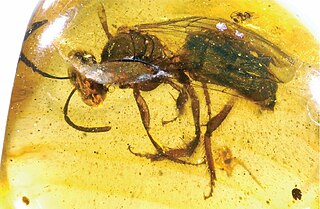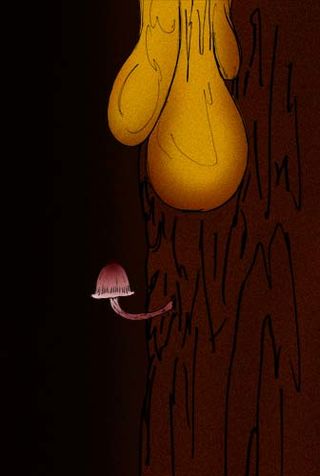
Halictidae is the second-largest family of bees with nearly 4,500 species. They are commonly called sweat bees, as they are often attracted to perspiration. Halictid species are an extremely diverse group that can vary greatly in appearance. These bees occur all over the world and are found on every continent except Antarctica. Usually dark-colored and often metallic, halictids are found in various sizes, colors and patterns. Several species are all or partly green and a few are red, purple, or blue. A number of them have yellow markings, especially the males, which commonly have yellow faces, a pattern widespread among the various families of bees. The family is one of many with short tongues and is best distinguished by the arcuate basal vein found on the wing. Females in this family tend to be larger than the males. They are the group for which the term 'eusocial' was first coined by entomologist, Suzanne Batra.
Neocorynura electra is an extinct species of sweat bee in the Halictidae genus Neocorynura.

Oligochlora is an extinct genus of sweat bee in the Halictidae subfamily Halictinae. The genus currently contains six species, all of which are known from the early Miocene Burdigalian stage Dominican amber deposits on the island of Hispaniola.
Eickwortapis is an extinct monotypic genus of sweat bee in the Halictidae subfamily Halictinae which contains the single species Eickwortapis dominicana.
Augochlora leptoloba is a species of sweat bee in the genus Augochlora and the extinct monotypic subgenus Electraugochlora.

Leptofoenus pittfieldae is an extinct species of wasp in the family Pteromalidae. It is known from early Miocene Burdigalian stage Dominican amber deposits on the island of Hispaniola. The species is known from a single 8.8 millimetres (0.35 in) male specimen excavated from the La Toca mine group northeast of Santiago de los Caballeros in 2008 and deposited in the Insect Fossil Collection at the University of Kansas Natural History Museum in Lawrence, Kansas, where it was studied and described by Dr. Michael S. Engel. The species name pittfieldae honors Ms. Morgan Pittfield, niece of the specimen donor.
Protosialis casca is an extinct species of alderfly in the Sialidae subfamily Sialinae. The species is solely known from the early Miocene, Burdigalian stage, Dominican amber deposits on the island of Hispaniola. Protosialis casca is one of only two known alderfly species present in the West Indies, the only other species is the living Protosialis bifasciata native to Cuba.

Protomycena is an extinct monotypic genus of gilled fungus in the family Mycenaceae, of order Agaricales. At present it contains the single species Protomycena electra, known from a single specimen collected in an amber mine in the Cordillera Septentrional area of the Dominican Republic. The fruit body of the fungus has a convex cap that is 5 mm (0.2 in) in diameter, with distantly spaced gills on the underside. The curved stipe is smooth and cylindrical, measuring 0.75 mm (0.030 in) thick by 10 mm (0.39 in) long, and lacks a ring. It resembles extant species of the genus Mycena. Protomycena is one of only five known agaric fungus species known in the fossil record and the second to be described from Dominican amber.
Halictus? savenyei is an extinct species of sweat bee possibly in the halictid genus Halictus. The species is solely known from the Early Eocene, Ypresian stage, Coldwater Beds, part of the Princeton Group, in the Quilchena area, Nicola Country, British Columbia, Canada.

Necroraphidia is an extinct genus of snakefly in the family Mesoraphidiidae. The genus is solely known from Early Cretaceous, Albian age, fossil amber found in Spain. Currently the genus comprises a single species, Necroraphidia arcuata.

Amarantoraphidia is an extinct genus of snakefly in the family Mesoraphidiidae. The genus is solely known from Early Cretaceous, Albian age, fossil amber found in Spain. Currently the genus comprises only a single species Amarantoraphidia ventolina.

Alavaraphidia is an extinct genus of snakefly in the family Mesoraphidiidae. The genus is solely known from an Early Cretaceous, Albian age, fossil amber found in Spain. Currently, the genus comprises a single species, Alavaraphidia imperterrita.
Zophotermes is an extinct genus of termite in the Isoptera family Rhinotermitidae known from two Eocene fossils found in India. The genus contains a single described species, Zophotermes ashoki placed in the subfamily Prorhinotermitinae.
Termitaradus dominicanus is an extinct species of termite bug in the family Termitaphididae known from a Miocene fossil found on Hispaniola. T. dominicanus is the third species in the genus Termitaradus to have been described from fossils found in Dominican amber after Termitaradus avitinquilinus and Termitaradus mitnicki.
Termitaradus protera is an extinct species of termite bug in the family Termitaphididae known from several Late Oligocene to Early Miocene fossils found in Mexico. T. protera is the only species in the extant genus Termitaradus to have been described from fossils found in Mexican amber and is one of four species from new world amber; the others are Termitaradus avitinquilinus, Termitaradus dominicanus and Termitaradus mitnicki. T. protera was also the first termite bug described from the fossil record.
Termitaradus avitinquilinus is an extinct species of termite bug in the family Termitaphididae known from several possibly Miocene fossils found in the Dominican Republic. T. avitinquilinus is the first species in the genus Termitaradus to have been described from fossils found in Dominican amber and is one of four species from New World amber, the others being Termitaradus protera, Termitaradus dominicanus and Termitaradus mitnicki.
Anthophorula (Anthophorula) persephone is an extinct species of bee in the subfamily Apinae known from a pair of possibly Miocene fossils found on Hispaniola. A. persephone is the first species of the bee tribe Exomalopsini to have been described from fossils found in Dominican amber and is the only species of Anthophorula found in the West Indies.

Anochetus corayi is an extinct species of ant in the subfamily Ponerinae known from one possibly Miocene fossil found on Hispaniola. A. corayi is one of eight species in the ant genus Anochetus to have been described from fossils found in Dominican amber and is one of a number of Anochetus species found in the Greater Antillies.

Aphaenogaster amphioceanica is an extinct species of ant in the subfamily Myrmicinae known from a single possibly Miocene fossil found in amber on Hispaniola. At the time of description A. amphioceanica was one of two Aphaenogaster species known from the Caribbean islands.
Dicromantispa moronei is an extinct species of mantidfly in the neuropteran family Mantispidae known from a fossil found in the Caribbean.









